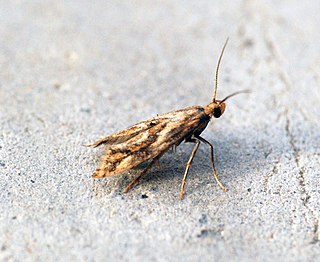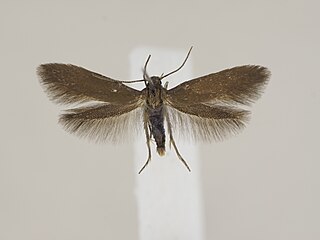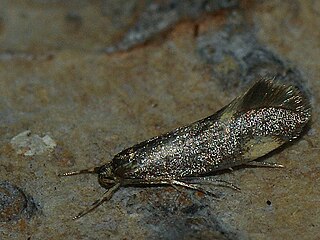
Epermeniidae or the fringe-tufted moths is a family of insects in the lepidopteran order with about 14 genera. Previously they have been divided in two subfamilies Epermeniinae and Ochromolopinae but this is no longer maintained since the last group is probably hierarchically nested within the first. They are presently placed in their own superfamily but have previously been placed among the Yponomeutoidea or Copromorphoidea with which they share some features. Their systematic placement among the apoditrysian group "Obtectomera" is however uncertain. They show some morphological similarities to the "plume moths", for example the wing fringe has similar groups of scales. There are also some similarities to Schreckensteinioidea, for example spiny legs and at least in some species an open-network cocoon. The genus Thambotricha from New Zealand may be the sister group of all other extant members. The most important genera are Epermenia, Ochromolopis and Gnathifera. The group has been extensively revised and catalogued by Dr Reinhard Gaedike.

Mompha raschkiella is a species of micromoth in the family Momphidae. The moth was first described by German entomologist Philipp Christoph Zeller in 1838.

Platyptilia isodactylus is a moth of the family Pterophoridae found in China, Europe and was introduced to Australia and New Zealand for biological control. It was first described by the German entomologists, Philipp Christoph Zeller in 1852.
Coleophora vibicigerella is a moth of the family Coleophoridae found in Asia, Europe and north Africa. It was first described by Philipp Christoph Zeller in 1839.

Coleophora niveicostella is a moth of the family Coleophoridae and was first described by Philipp Christoph Zeller in 1839. It is found from Sweden and Latvia to Spain, Italy and Greece and from Great Britain to Romania.

Agonopterix ciliella is a moth of the family Depressariidae. It is found in most of Europe, except the Iberian Peninsula, most of the Balkan Peninsula and the Benelux. It is also found in North America.

Agonopterix conterminella is a moth of the family Depressariidae which is found in Asia, Europe and North America. It was described by Philipp Christoph Zeller in 1839 from a specimen found in Augsburg, Germany. The larvae feed on the terminal shoots of willows.

Agonopterix curvipunctosa is a moth of the family Depressariidae. It is found in most of Europe, except Ireland, Portugal, Finland, the Baltic region and the western and southern part of the Balkan Peninsula.

Epermenia falciformis, also known as the large lance-wing, is a moth of the family Epermeniidae found in Europe. It was first described by Adrian Hardy Haworth in 1828.

Epermenia aequidentellus, also known as the carrot lance-wing, is a moth of the family Epermeniidae found in Europe, Madeira and the Canary Islands. It was first described by Ernest Hofmann in 1867, from a specimen found in Vorderer Kaiser, near Kufstein, Austria.

Bucculatrix ulmella is a moth of the family Bucculatricidae. It is found in most of Europe, except the Iberian Peninsula, Slovenia and Bulgaria. It was first described in 1848 by Philipp Christoph Zeller.

Epermenia chaerophyllella, also known as the garden lance-wing, is a moth of the family Epermeniidae first described by Johann August Ephraim Goeze in 1783. It is found in all of Europe and Asia Minor.
Epermenia insecurella, the chalk-hill lance-wing, is a moth of the family Epermeniidae. It is found in most of Europe, Asia Minor, the Near East and Mongolia.

Phaulernis fulviguttella, the yellow-spotted lance-wing, is a moth of the family Epermeniidae found in the Palearctic including Europe.
Phaulernis chasanica is a moth of the family Epermeniidae. It is found in the Russian Far East and Japan.
Epermenia farreni, the scarce lance-wing, is a moth of the family Epermeniidae found in Asia and Europe. It was first described by Thomas de Grey, 6th Baron Walsingham in 1894 from a specimen found in Cambridge, England.

Epermenia profugella, also known as the little lance-wing is a moth of the family Epermeniidae found in northern, central and eastern Europe. The moth was first described by Henry Tibbats Stainton in 1856, from a specimen found in Kemsing, Kent, England.

Metalampra cinnamomea is a moth of the family Oecophoridae. It was described by Philipp Christoph Zeller in 1839. It is found in most of Europe, except the Iberian Peninsula, most of the Balkan Peninsula, Ireland and Great Britain.

Scythris cicadella, the sand owlet, is a moth of the family Scythrididae found in Europe. It was first described by Philipp Christoph Zeller in 1839.
Phaulernis is a genus of moths in the family Epermeniidae.














